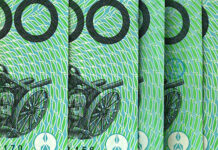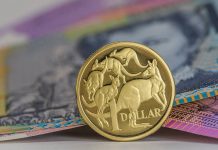Growth and interest rate differentials to weigh on AUD in time.
It has been an eventful month for the Australian economy, with GDP and other key data surprising to the downside, and interest rate expectations shifting. Regardless, at USD0.7094, the Australian dollar is unchanged from USD0.7093 when our February Market Outlook went to print, having held a fairly tight range of USD0.7009 to USD0.7183 since.
The detail of the December National Accounts is laid out on page 8 of our March Market Outlook. With respect to the currency, all that needs to be stated is that from a 4% annualised pace in the first half of 2018, GDP growth slowed to just 1% annualised in the second. On the back of this dramatic deceleration, and given our concerns around the effect of declining house prices and soft household income growth on consumption, we look for growth to remain materially below trend at 2.2%yr in both 2019 and 2020. Versus the US, relative growth comparisons will then remain a material headwind for the Australian dollar over the forecast period.
A consequence of Australia’s weak economic growth and the skew of global risks is a need for further monetary policy easing by the RBA. We believe this is most likely to take the form of two 25bp cash rate cuts in 2019 – the first delivered in August, the second come November.
If we are also correct in forecasting one final rate hike for this cycle from the US FOMC, then by end-2019, the policy rate differential between Australia and the US would stretch to –163bps – a highly-abnormal spread versus history. Albeit at the whim of the market, such a policy outturn should also see the Australia/US 10-year yield spread widen from around –60bps currently to nearer –90bps through mid-2019, after which it will likely remain historically wide as both the RBA and FOMC go on hold in 2020 (a spread of –65bps is expected at end-2020).
Against the scale of the above Australia/ US differentials for growth and interest rates, our forecast for around a 4% decline in the Australian dollar to USD0.68 in the second half of 2019 appears modest. The justification for maintaining this forecast is two-fold: (1) key commodity prices continue to hold up better than anticipated; and (2) demand for Australian assets from foreign investors remains very strong.
For Australia, iron ore and coal prices remain key. Over the past year, both markets have seen significant supply disruptions and a seeming unwillingness (or inability) of producers to quickly offset the production loss. Coupled with ongoing structural reform (which preferences high-quality inputs) and strengthening construction-related demand for steel in China, impaired supply has resulted in elevated price levels for both iron ore and metallurgical coal, respectively US$87/t and US$183/t. In terms of the expected return for miners from current production and broader sentiment for the Australian dollar, this is a clear positive.
While we anticipate a pull-back in prices through 2019 and 2020 (to US$75/t end-2019 and US$65/t end-2020 for iron ore; and to US$150/t end-2019 and US$135/t end-2020 for metallurgical coal), the pace of decline will be measured as supply takes time to correct. For Australian dollar demand, it also seems probable that some of this decline in unit prices will be offset by higher volumes over the forecast horizon. All of this considered, we believe the Australian dollar will gradually edge back up from USD0.68 end-2019 to USD0.70 at end-2020.
Extending our analysis from trade receipt flows to investment/capital flows, it becomes apparent that the Australian dollar will likely receive additional support in the near term. In recent months, Australian resource companies have actioned a number of capital management strategies to return excess cash to investors, ahead of potential changes to franking credit rules after the coming Federal election and given a limited need for capital for capacity expansion. As a large portion of the share registers of these firms are domiciled in Australia, this has provided persistent support for the Australian dollar which could last to the end of FY2019.
More broadly, as at December 2018, it was evident from the ABS Balance of Payments release that foreign investor demand for Australian assets remains very strong. Of particular note, direct investment flows (defined as a 10%+ stake in a company) amounted to $76bn in 2018, almost one and a half times the seven-year average back to 2011 – already a historically strong period for direct investment flows. Whereas during the mining investment boom, direct capital was used to fund new real economy investment, currently it is more a result of foreign investors’ desire for existing income-yielding assets in Australia. This demand is also evident in portfolio inflows into Australian debt securities, which at $74bn was also robust in 2018.
While support from these yield-seeking flows will persist, given the global backdrop and Australia’s growth outlook, it seems inevitable that they will moderate hence. Ergo, the ability for the Australian dollar to maintain or exceed the USD0.70 figure is only likely to remain until mid-2019 after which the above growth; interest rate; and commodity dynamics will re-assert.












